S2 2019 ACCG224: Financial Analysis and Accounting Policies Report
VerifiedAdded on 2022/10/04
|9
|1551
|18
Report
AI Summary
This report provides an in-depth analysis of accounting policies, focusing on the selection criteria and changes in accounting policies according to AASB 108. It delves into the accounting policies and estimates of Harvey Norman, including the consolidation of subsidiaries, revaluation of properties, and provisions for uncertainties. The report highlights the application of professional judgment in determining fair values for property, plant, and equipment, emphasizing market evidence and independent valuations. It also examines the treatment of revaluation surpluses and deficits. The conclusion underscores the importance of appropriate assumptions in determining fair values and the use of multiple methods. References to relevant accounting standards and Harvey Norman's annual report are included.
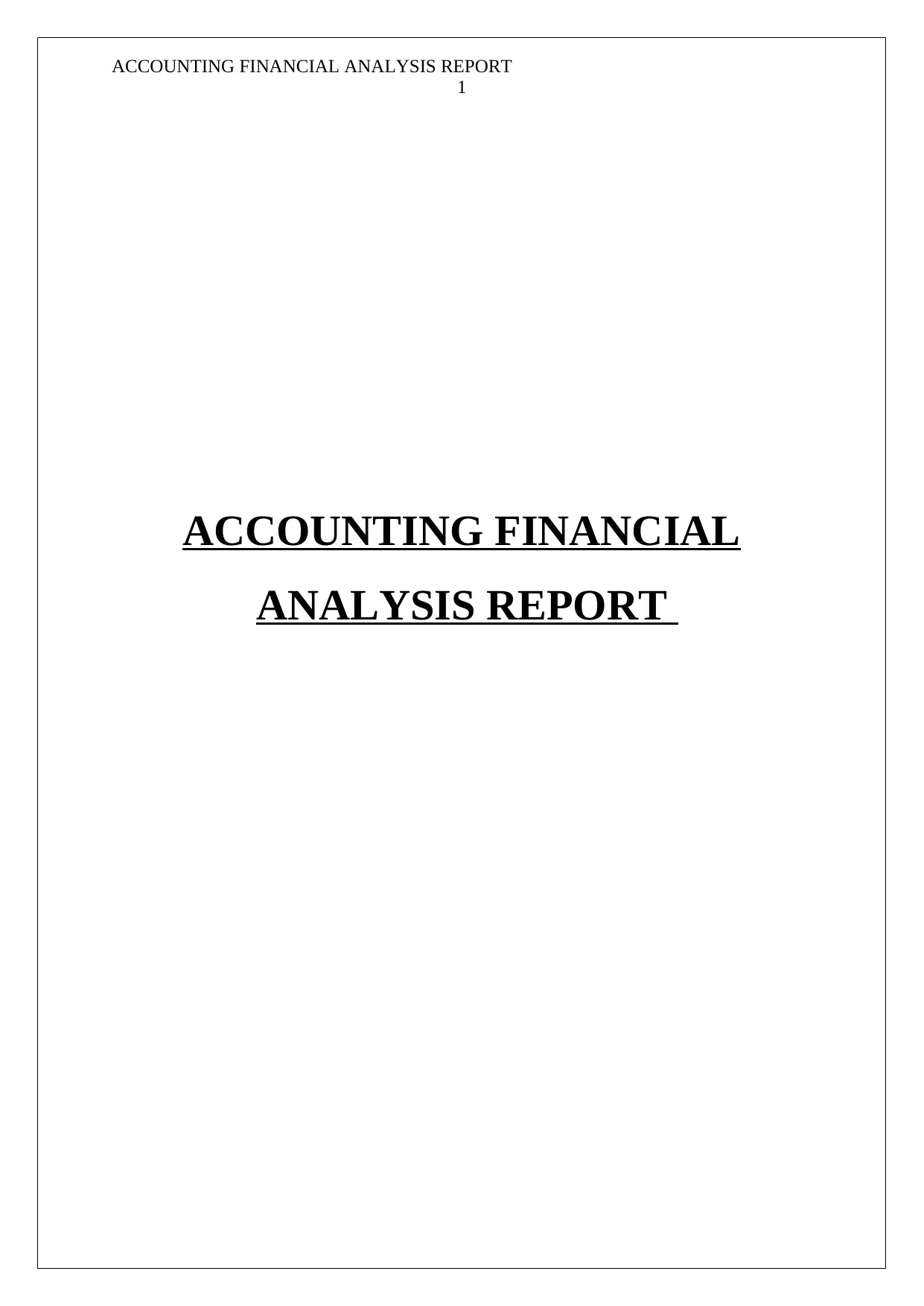
ACCOUNTING FINANCIAL ANALYSIS REPORT
1
ACCOUNTING FINANCIAL
ANALYSIS REPORT
1
ACCOUNTING FINANCIAL
ANALYSIS REPORT
Paraphrase This Document
Need a fresh take? Get an instant paraphrase of this document with our AI Paraphraser
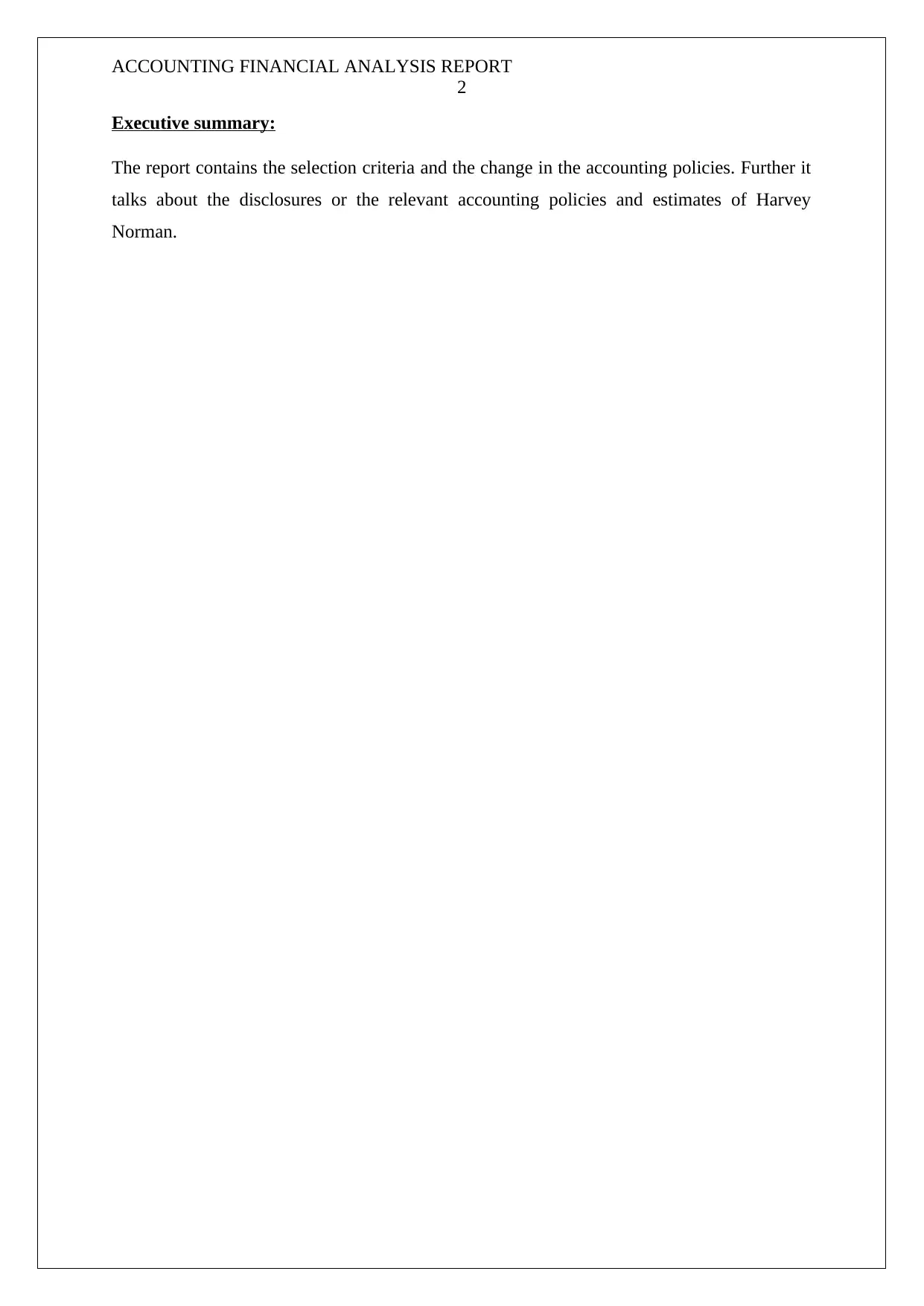
ACCOUNTING FINANCIAL ANALYSIS REPORT
2
Executive summary:
The report contains the selection criteria and the change in the accounting policies. Further it
talks about the disclosures or the relevant accounting policies and estimates of Harvey
Norman.
2
Executive summary:
The report contains the selection criteria and the change in the accounting policies. Further it
talks about the disclosures or the relevant accounting policies and estimates of Harvey
Norman.
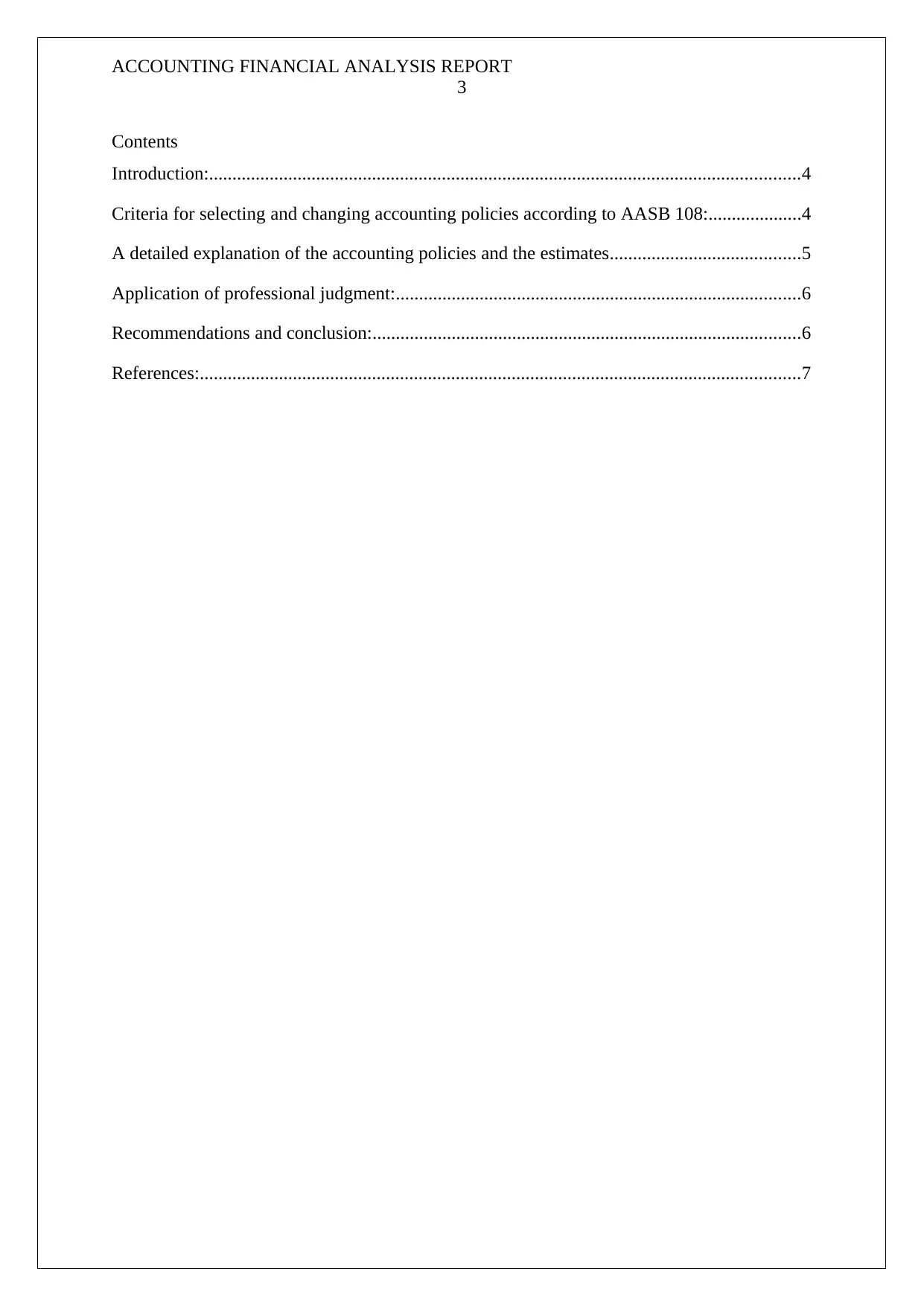
ACCOUNTING FINANCIAL ANALYSIS REPORT
3
Contents
Introduction:...............................................................................................................................4
Criteria for selecting and changing accounting policies according to AASB 108:....................4
A detailed explanation of the accounting policies and the estimates.........................................5
Application of professional judgment:.......................................................................................6
Recommendations and conclusion:............................................................................................6
References:.................................................................................................................................7
3
Contents
Introduction:...............................................................................................................................4
Criteria for selecting and changing accounting policies according to AASB 108:....................4
A detailed explanation of the accounting policies and the estimates.........................................5
Application of professional judgment:.......................................................................................6
Recommendations and conclusion:............................................................................................6
References:.................................................................................................................................7
⊘ This is a preview!⊘
Do you want full access?
Subscribe today to unlock all pages.

Trusted by 1+ million students worldwide
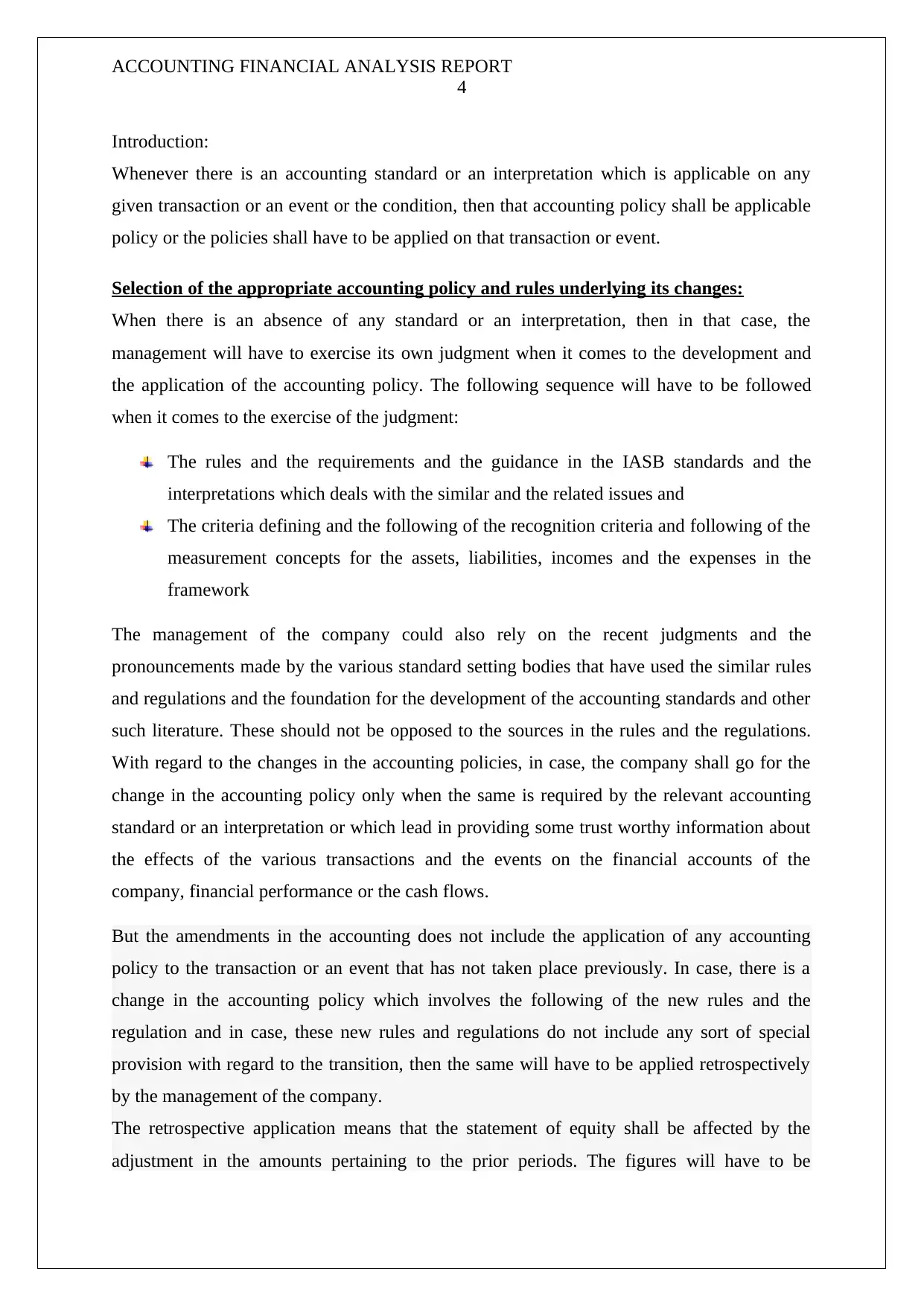
ACCOUNTING FINANCIAL ANALYSIS REPORT
4
Introduction:
Whenever there is an accounting standard or an interpretation which is applicable on any
given transaction or an event or the condition, then that accounting policy shall be applicable
policy or the policies shall have to be applied on that transaction or event.
Selection of the appropriate accounting policy and rules underlying its changes:
When there is an absence of any standard or an interpretation, then in that case, the
management will have to exercise its own judgment when it comes to the development and
the application of the accounting policy. The following sequence will have to be followed
when it comes to the exercise of the judgment:
The rules and the requirements and the guidance in the IASB standards and the
interpretations which deals with the similar and the related issues and
The criteria defining and the following of the recognition criteria and following of the
measurement concepts for the assets, liabilities, incomes and the expenses in the
framework
The management of the company could also rely on the recent judgments and the
pronouncements made by the various standard setting bodies that have used the similar rules
and regulations and the foundation for the development of the accounting standards and other
such literature. These should not be opposed to the sources in the rules and the regulations.
With regard to the changes in the accounting policies, in case, the company shall go for the
change in the accounting policy only when the same is required by the relevant accounting
standard or an interpretation or which lead in providing some trust worthy information about
the effects of the various transactions and the events on the financial accounts of the
company, financial performance or the cash flows.
But the amendments in the accounting does not include the application of any accounting
policy to the transaction or an event that has not taken place previously. In case, there is a
change in the accounting policy which involves the following of the new rules and the
regulation and in case, these new rules and regulations do not include any sort of special
provision with regard to the transition, then the same will have to be applied retrospectively
by the management of the company.
The retrospective application means that the statement of equity shall be affected by the
adjustment in the amounts pertaining to the prior periods. The figures will have to be
4
Introduction:
Whenever there is an accounting standard or an interpretation which is applicable on any
given transaction or an event or the condition, then that accounting policy shall be applicable
policy or the policies shall have to be applied on that transaction or event.
Selection of the appropriate accounting policy and rules underlying its changes:
When there is an absence of any standard or an interpretation, then in that case, the
management will have to exercise its own judgment when it comes to the development and
the application of the accounting policy. The following sequence will have to be followed
when it comes to the exercise of the judgment:
The rules and the requirements and the guidance in the IASB standards and the
interpretations which deals with the similar and the related issues and
The criteria defining and the following of the recognition criteria and following of the
measurement concepts for the assets, liabilities, incomes and the expenses in the
framework
The management of the company could also rely on the recent judgments and the
pronouncements made by the various standard setting bodies that have used the similar rules
and regulations and the foundation for the development of the accounting standards and other
such literature. These should not be opposed to the sources in the rules and the regulations.
With regard to the changes in the accounting policies, in case, the company shall go for the
change in the accounting policy only when the same is required by the relevant accounting
standard or an interpretation or which lead in providing some trust worthy information about
the effects of the various transactions and the events on the financial accounts of the
company, financial performance or the cash flows.
But the amendments in the accounting does not include the application of any accounting
policy to the transaction or an event that has not taken place previously. In case, there is a
change in the accounting policy which involves the following of the new rules and the
regulation and in case, these new rules and regulations do not include any sort of special
provision with regard to the transition, then the same will have to be applied retrospectively
by the management of the company.
The retrospective application means that the statement of equity shall be affected by the
adjustment in the amounts pertaining to the prior periods. The figures will have to be
Paraphrase This Document
Need a fresh take? Get an instant paraphrase of this document with our AI Paraphraser
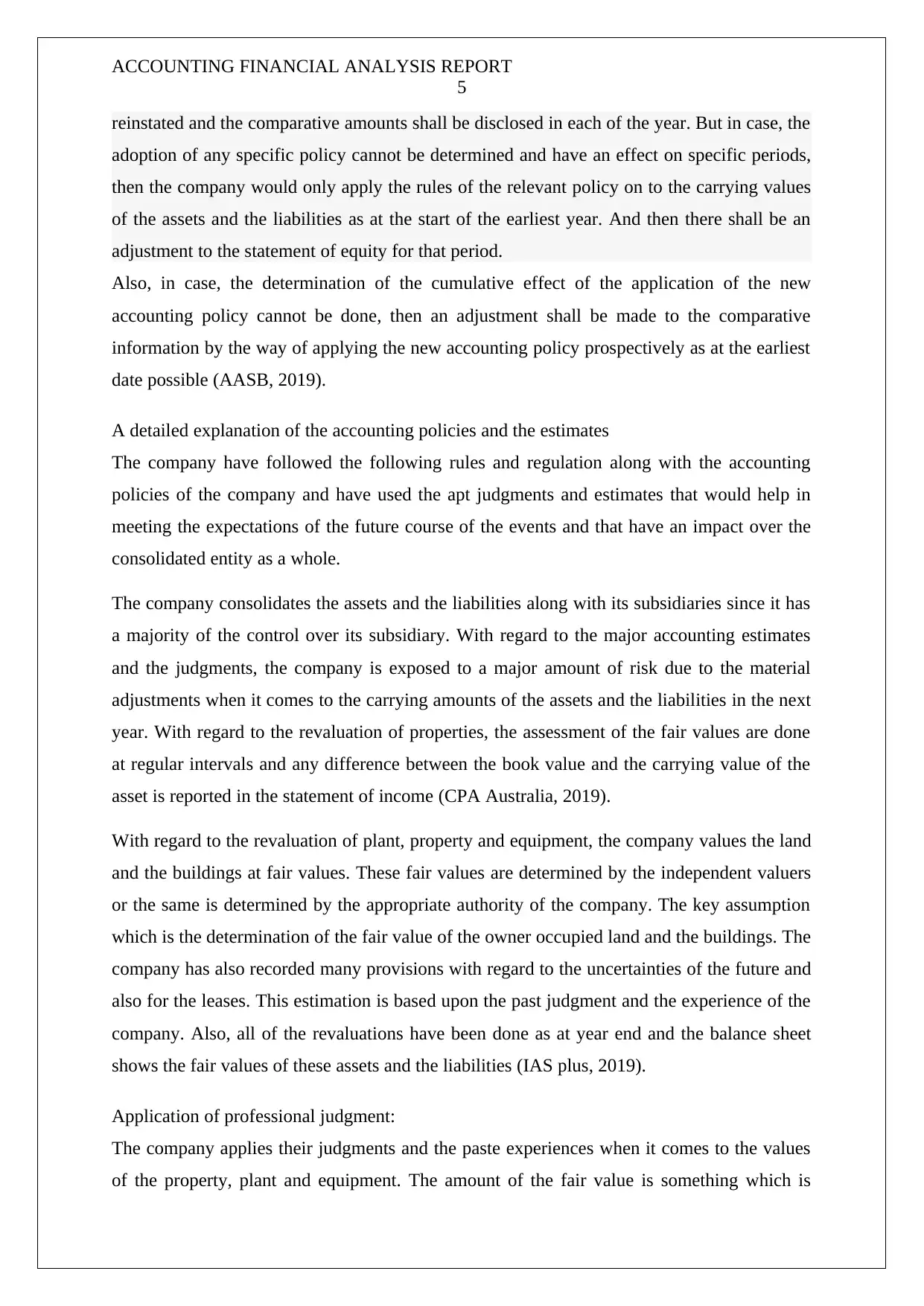
ACCOUNTING FINANCIAL ANALYSIS REPORT
5
reinstated and the comparative amounts shall be disclosed in each of the year. But in case, the
adoption of any specific policy cannot be determined and have an effect on specific periods,
then the company would only apply the rules of the relevant policy on to the carrying values
of the assets and the liabilities as at the start of the earliest year. And then there shall be an
adjustment to the statement of equity for that period.
Also, in case, the determination of the cumulative effect of the application of the new
accounting policy cannot be done, then an adjustment shall be made to the comparative
information by the way of applying the new accounting policy prospectively as at the earliest
date possible (AASB, 2019).
A detailed explanation of the accounting policies and the estimates
The company have followed the following rules and regulation along with the accounting
policies of the company and have used the apt judgments and estimates that would help in
meeting the expectations of the future course of the events and that have an impact over the
consolidated entity as a whole.
The company consolidates the assets and the liabilities along with its subsidiaries since it has
a majority of the control over its subsidiary. With regard to the major accounting estimates
and the judgments, the company is exposed to a major amount of risk due to the material
adjustments when it comes to the carrying amounts of the assets and the liabilities in the next
year. With regard to the revaluation of properties, the assessment of the fair values are done
at regular intervals and any difference between the book value and the carrying value of the
asset is reported in the statement of income (CPA Australia, 2019).
With regard to the revaluation of plant, property and equipment, the company values the land
and the buildings at fair values. These fair values are determined by the independent valuers
or the same is determined by the appropriate authority of the company. The key assumption
which is the determination of the fair value of the owner occupied land and the buildings. The
company has also recorded many provisions with regard to the uncertainties of the future and
also for the leases. This estimation is based upon the past judgment and the experience of the
company. Also, all of the revaluations have been done as at year end and the balance sheet
shows the fair values of these assets and the liabilities (IAS plus, 2019).
Application of professional judgment:
The company applies their judgments and the paste experiences when it comes to the values
of the property, plant and equipment. The amount of the fair value is something which is
5
reinstated and the comparative amounts shall be disclosed in each of the year. But in case, the
adoption of any specific policy cannot be determined and have an effect on specific periods,
then the company would only apply the rules of the relevant policy on to the carrying values
of the assets and the liabilities as at the start of the earliest year. And then there shall be an
adjustment to the statement of equity for that period.
Also, in case, the determination of the cumulative effect of the application of the new
accounting policy cannot be done, then an adjustment shall be made to the comparative
information by the way of applying the new accounting policy prospectively as at the earliest
date possible (AASB, 2019).
A detailed explanation of the accounting policies and the estimates
The company have followed the following rules and regulation along with the accounting
policies of the company and have used the apt judgments and estimates that would help in
meeting the expectations of the future course of the events and that have an impact over the
consolidated entity as a whole.
The company consolidates the assets and the liabilities along with its subsidiaries since it has
a majority of the control over its subsidiary. With regard to the major accounting estimates
and the judgments, the company is exposed to a major amount of risk due to the material
adjustments when it comes to the carrying amounts of the assets and the liabilities in the next
year. With regard to the revaluation of properties, the assessment of the fair values are done
at regular intervals and any difference between the book value and the carrying value of the
asset is reported in the statement of income (CPA Australia, 2019).
With regard to the revaluation of plant, property and equipment, the company values the land
and the buildings at fair values. These fair values are determined by the independent valuers
or the same is determined by the appropriate authority of the company. The key assumption
which is the determination of the fair value of the owner occupied land and the buildings. The
company has also recorded many provisions with regard to the uncertainties of the future and
also for the leases. This estimation is based upon the past judgment and the experience of the
company. Also, all of the revaluations have been done as at year end and the balance sheet
shows the fair values of these assets and the liabilities (IAS plus, 2019).
Application of professional judgment:
The company applies their judgments and the paste experiences when it comes to the values
of the property, plant and equipment. The amount of the fair value is something which is
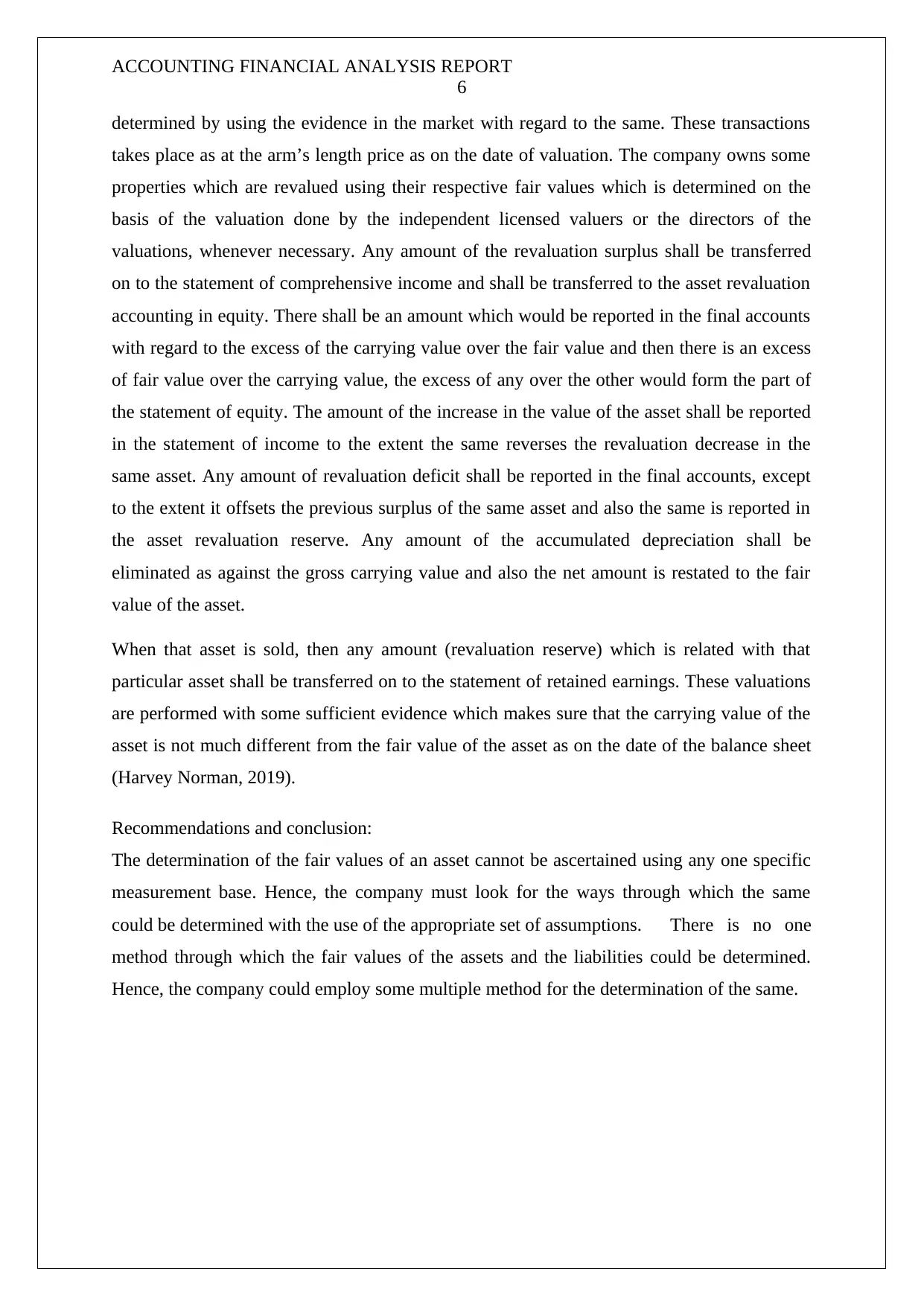
ACCOUNTING FINANCIAL ANALYSIS REPORT
6
determined by using the evidence in the market with regard to the same. These transactions
takes place as at the arm’s length price as on the date of valuation. The company owns some
properties which are revalued using their respective fair values which is determined on the
basis of the valuation done by the independent licensed valuers or the directors of the
valuations, whenever necessary. Any amount of the revaluation surplus shall be transferred
on to the statement of comprehensive income and shall be transferred to the asset revaluation
accounting in equity. There shall be an amount which would be reported in the final accounts
with regard to the excess of the carrying value over the fair value and then there is an excess
of fair value over the carrying value, the excess of any over the other would form the part of
the statement of equity. The amount of the increase in the value of the asset shall be reported
in the statement of income to the extent the same reverses the revaluation decrease in the
same asset. Any amount of revaluation deficit shall be reported in the final accounts, except
to the extent it offsets the previous surplus of the same asset and also the same is reported in
the asset revaluation reserve. Any amount of the accumulated depreciation shall be
eliminated as against the gross carrying value and also the net amount is restated to the fair
value of the asset.
When that asset is sold, then any amount (revaluation reserve) which is related with that
particular asset shall be transferred on to the statement of retained earnings. These valuations
are performed with some sufficient evidence which makes sure that the carrying value of the
asset is not much different from the fair value of the asset as on the date of the balance sheet
(Harvey Norman, 2019).
Recommendations and conclusion:
The determination of the fair values of an asset cannot be ascertained using any one specific
measurement base. Hence, the company must look for the ways through which the same
could be determined with the use of the appropriate set of assumptions. There is no one
method through which the fair values of the assets and the liabilities could be determined.
Hence, the company could employ some multiple method for the determination of the same.
6
determined by using the evidence in the market with regard to the same. These transactions
takes place as at the arm’s length price as on the date of valuation. The company owns some
properties which are revalued using their respective fair values which is determined on the
basis of the valuation done by the independent licensed valuers or the directors of the
valuations, whenever necessary. Any amount of the revaluation surplus shall be transferred
on to the statement of comprehensive income and shall be transferred to the asset revaluation
accounting in equity. There shall be an amount which would be reported in the final accounts
with regard to the excess of the carrying value over the fair value and then there is an excess
of fair value over the carrying value, the excess of any over the other would form the part of
the statement of equity. The amount of the increase in the value of the asset shall be reported
in the statement of income to the extent the same reverses the revaluation decrease in the
same asset. Any amount of revaluation deficit shall be reported in the final accounts, except
to the extent it offsets the previous surplus of the same asset and also the same is reported in
the asset revaluation reserve. Any amount of the accumulated depreciation shall be
eliminated as against the gross carrying value and also the net amount is restated to the fair
value of the asset.
When that asset is sold, then any amount (revaluation reserve) which is related with that
particular asset shall be transferred on to the statement of retained earnings. These valuations
are performed with some sufficient evidence which makes sure that the carrying value of the
asset is not much different from the fair value of the asset as on the date of the balance sheet
(Harvey Norman, 2019).
Recommendations and conclusion:
The determination of the fair values of an asset cannot be ascertained using any one specific
measurement base. Hence, the company must look for the ways through which the same
could be determined with the use of the appropriate set of assumptions. There is no one
method through which the fair values of the assets and the liabilities could be determined.
Hence, the company could employ some multiple method for the determination of the same.
⊘ This is a preview!⊘
Do you want full access?
Subscribe today to unlock all pages.

Trusted by 1+ million students worldwide
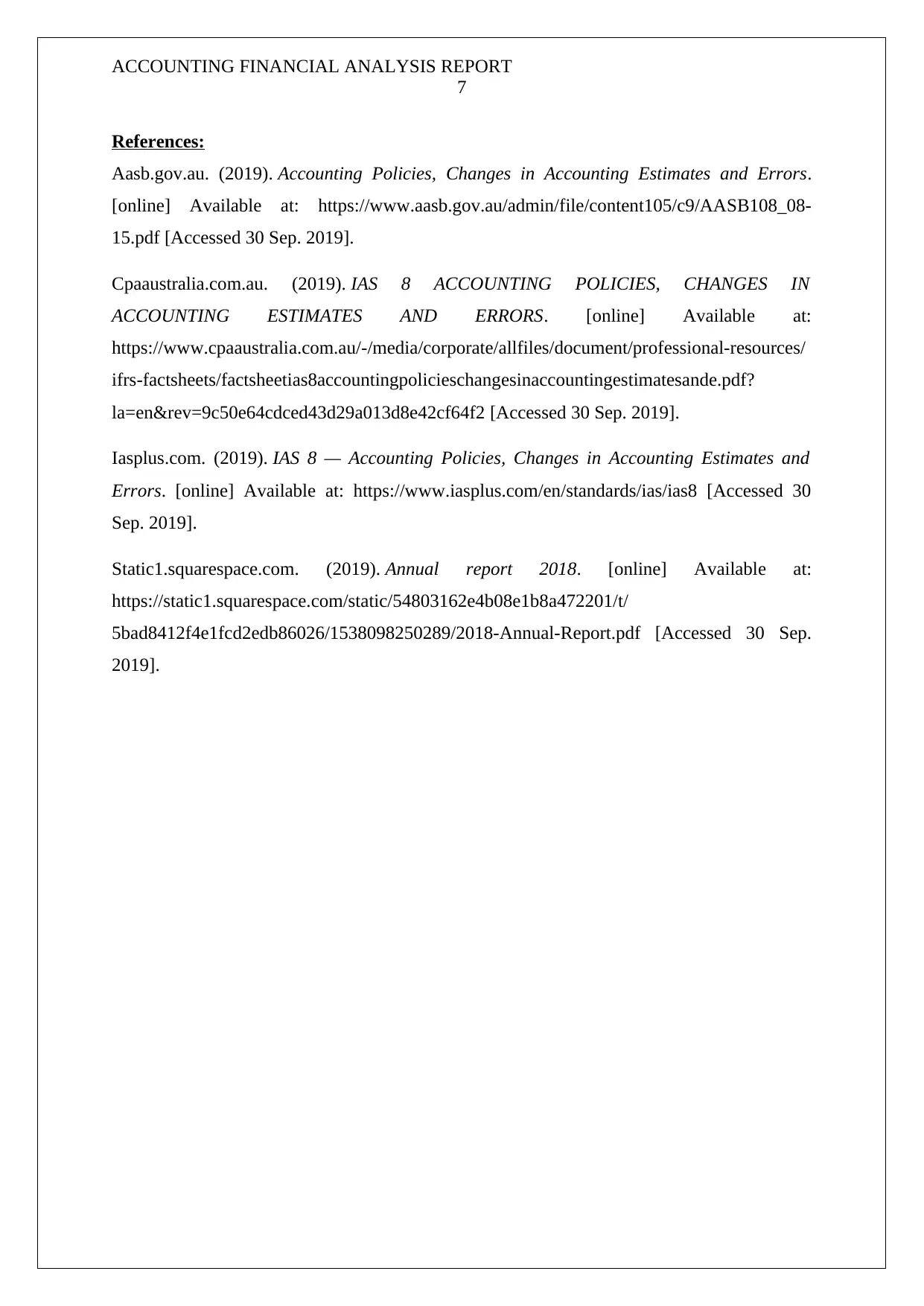
ACCOUNTING FINANCIAL ANALYSIS REPORT
7
References:
Aasb.gov.au. (2019). Accounting Policies, Changes in Accounting Estimates and Errors.
[online] Available at: https://www.aasb.gov.au/admin/file/content105/c9/AASB108_08-
15.pdf [Accessed 30 Sep. 2019].
Cpaaustralia.com.au. (2019). IAS 8 ACCOUNTING POLICIES, CHANGES IN
ACCOUNTING ESTIMATES AND ERRORS. [online] Available at:
https://www.cpaaustralia.com.au/-/media/corporate/allfiles/document/professional-resources/
ifrs-factsheets/factsheetias8accountingpolicieschangesinaccountingestimatesande.pdf?
la=en&rev=9c50e64cdced43d29a013d8e42cf64f2 [Accessed 30 Sep. 2019].
Iasplus.com. (2019). IAS 8 — Accounting Policies, Changes in Accounting Estimates and
Errors. [online] Available at: https://www.iasplus.com/en/standards/ias/ias8 [Accessed 30
Sep. 2019].
Static1.squarespace.com. (2019). Annual report 2018. [online] Available at:
https://static1.squarespace.com/static/54803162e4b08e1b8a472201/t/
5bad8412f4e1fcd2edb86026/1538098250289/2018-Annual-Report.pdf [Accessed 30 Sep.
2019].
7
References:
Aasb.gov.au. (2019). Accounting Policies, Changes in Accounting Estimates and Errors.
[online] Available at: https://www.aasb.gov.au/admin/file/content105/c9/AASB108_08-
15.pdf [Accessed 30 Sep. 2019].
Cpaaustralia.com.au. (2019). IAS 8 ACCOUNTING POLICIES, CHANGES IN
ACCOUNTING ESTIMATES AND ERRORS. [online] Available at:
https://www.cpaaustralia.com.au/-/media/corporate/allfiles/document/professional-resources/
ifrs-factsheets/factsheetias8accountingpolicieschangesinaccountingestimatesande.pdf?
la=en&rev=9c50e64cdced43d29a013d8e42cf64f2 [Accessed 30 Sep. 2019].
Iasplus.com. (2019). IAS 8 — Accounting Policies, Changes in Accounting Estimates and
Errors. [online] Available at: https://www.iasplus.com/en/standards/ias/ias8 [Accessed 30
Sep. 2019].
Static1.squarespace.com. (2019). Annual report 2018. [online] Available at:
https://static1.squarespace.com/static/54803162e4b08e1b8a472201/t/
5bad8412f4e1fcd2edb86026/1538098250289/2018-Annual-Report.pdf [Accessed 30 Sep.
2019].
Paraphrase This Document
Need a fresh take? Get an instant paraphrase of this document with our AI Paraphraser
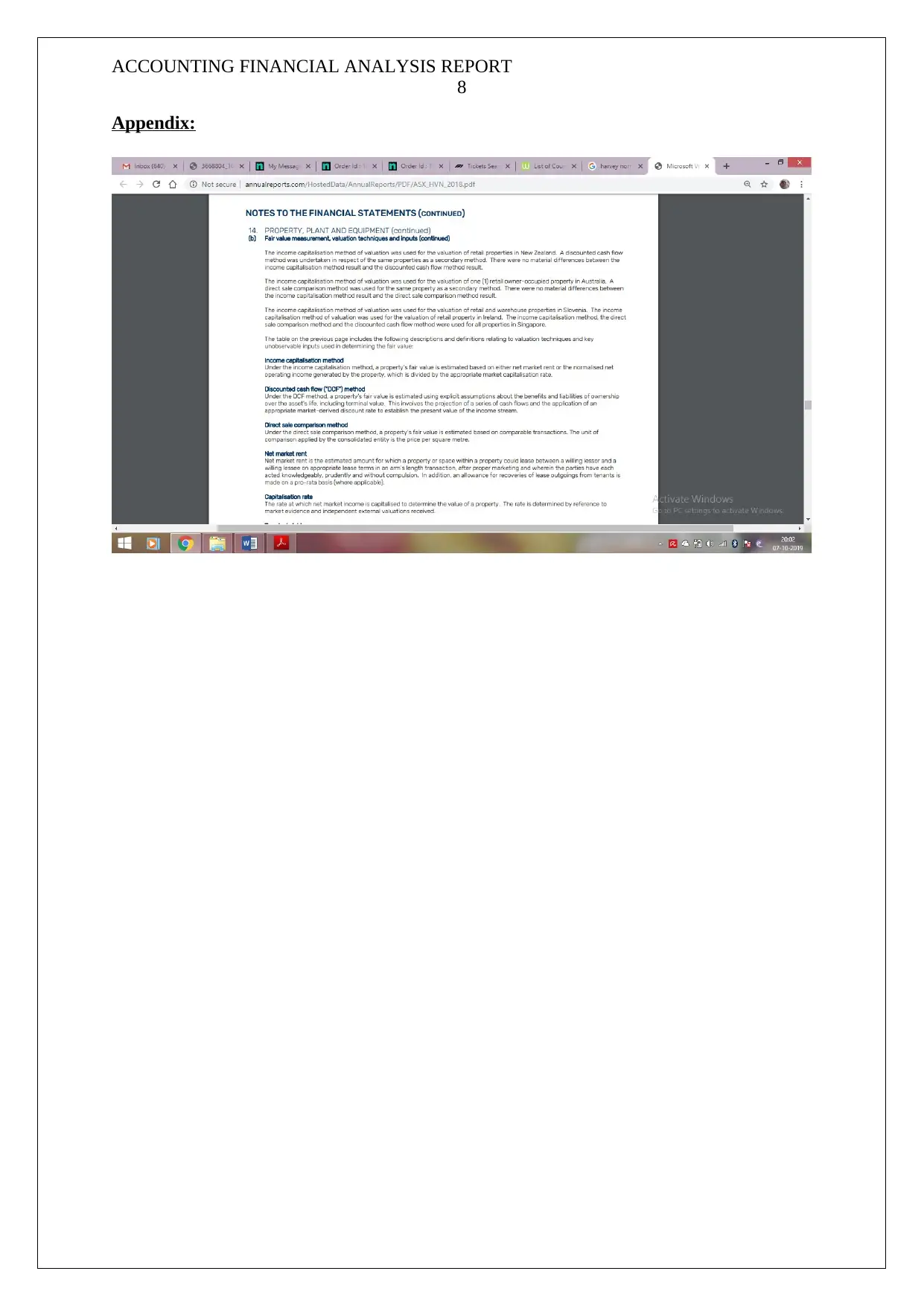
ACCOUNTING FINANCIAL ANALYSIS REPORT
8
Appendix:
8
Appendix:
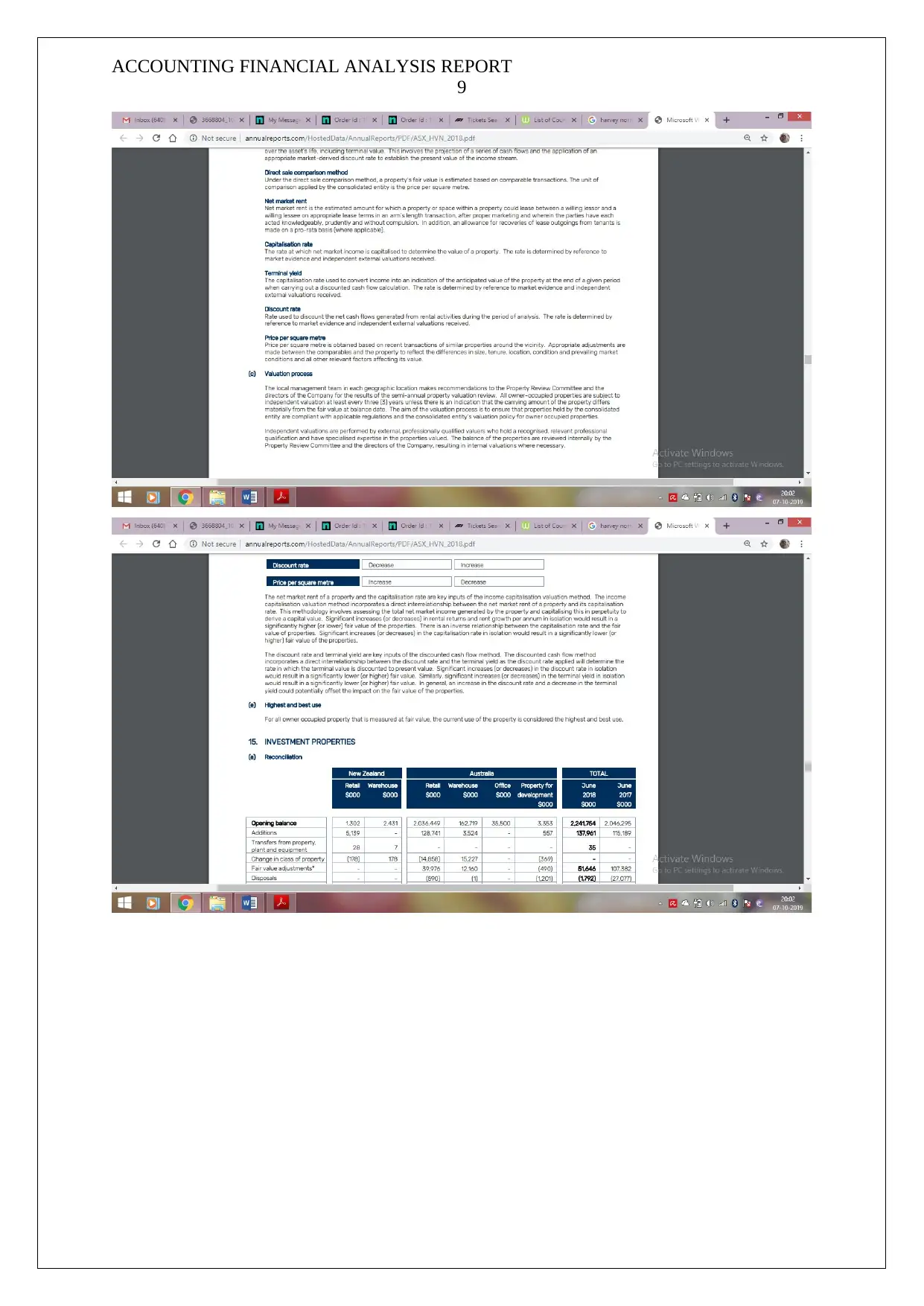
ACCOUNTING FINANCIAL ANALYSIS REPORT
9
9
⊘ This is a preview!⊘
Do you want full access?
Subscribe today to unlock all pages.

Trusted by 1+ million students worldwide
1 out of 9
Related Documents
Your All-in-One AI-Powered Toolkit for Academic Success.
+13062052269
info@desklib.com
Available 24*7 on WhatsApp / Email
![[object Object]](/_next/static/media/star-bottom.7253800d.svg)
Unlock your academic potential
Copyright © 2020–2025 A2Z Services. All Rights Reserved. Developed and managed by ZUCOL.





